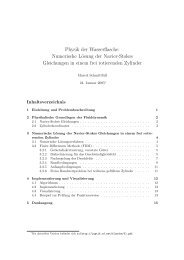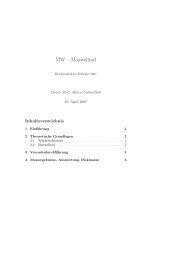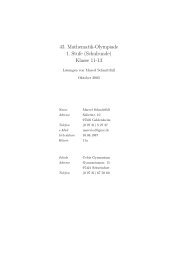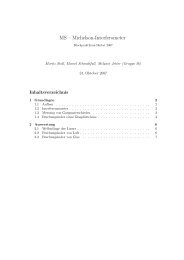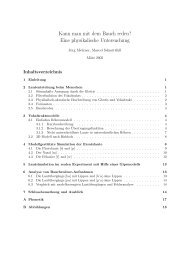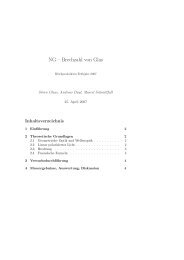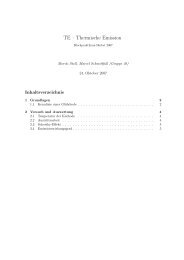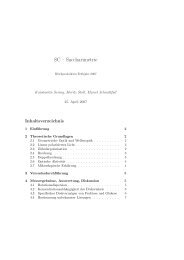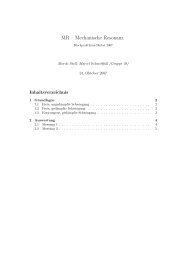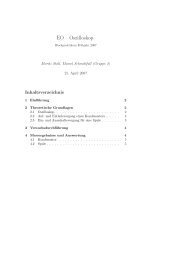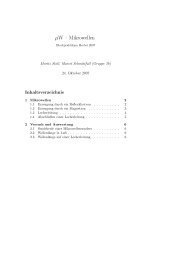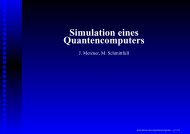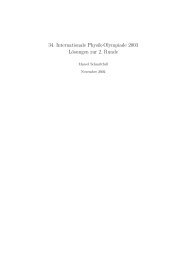JavaPsi - Simulating and Visualizing Quantum Mechanics (english)
JavaPsi - Simulating and Visualizing Quantum Mechanics (english)
JavaPsi - Simulating and Visualizing Quantum Mechanics (english)
You also want an ePaper? Increase the reach of your titles
YUMPU automatically turns print PDFs into web optimized ePapers that Google loves.
2 BASICS OF QUANTUM MECHANICS 2<br />
1 Introduction<br />
The aim of this project is to simulate <strong>and</strong> visualize the behavior of particles<br />
in quantum mechanics with an interactive Java program. Almost all input<br />
data are modifiable by user interaction during runtime. In particular, the<br />
shape of the potential in which the particle ’lives’ can be entered freely<br />
by mouse <strong>and</strong> the eigenfunctions are shown by selecting the corresponding<br />
energy eigenvalues.<br />
The program computes time-dependent or time-independent solutions,<br />
either of one-, two- or three-dimensional Schrödinger equation. In the onedimensonal<br />
time-independant case the wave function is numerically calculated<br />
by the Numerov algorithm, the energy eigenvalues are found by<br />
a shooting method. The complex-valued time-dependant wave-function,<br />
which is evaluated using the Goldberg-Schey-Schwartz algorithm, can either<br />
be animated or plotted as a function of space <strong>and</strong> time, whereby the<br />
real <strong>and</strong> imaginary parts are visualized using a color map.<br />
The wave-functions of a three-dimensional spherical potential are calculated<br />
by reducing the problem to the one-dimensonal case using radial <strong>and</strong><br />
spherical eigenfunctions <strong>and</strong> solving the problem again using Numerov’s algorithm.<br />
Comparisons of the calculated wave-functions with analytical solutions<br />
of well-known potentials (e.g. free particle, simple boxes <strong>and</strong> walls, harmonic<br />
oscillator, etc.) are made <strong>and</strong> show the accuracy of the code.<br />
Especially, the program is suitable for educational purposes due to its<br />
ability to elucidate a large variety of quantum mechanical principles <strong>and</strong><br />
effects, such as wave property of particles, tunnel effects, or the behavior in<br />
arbitrary potentials.<br />
2 Basics of quantum mechanics<br />
Since the behavior of microscopic particles such as electrons <strong>and</strong> photons<br />
cannot be described by classical mechanics, quantum mechanics was developped<br />
in the beginnging of the 20th century. The following section shall<br />
introduce the basical physical background of this theory.<br />
2.1 Superposition of states<br />
One central idea of quantum mechanics is the state of a particle. In contrary<br />
to classical mechanics, it is not possible to measure all values of a state<br />
with arbitrary accuracy. For example, one cannot exactly determine the<br />
momentum <strong>and</strong> the position of a particle at the same time. Particles can<br />
be in a superposition of several states, whereby it is interesting to note that<br />
these different states of a particle may interact with each other leading for<br />
example to the interference observed in the double slit experiment. Even<br />
if only one single particle goes through the double slit, interference can<br />
be observed. Thus, the particle is in a superposition containing the ways<br />
through the two slits.



